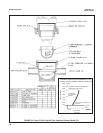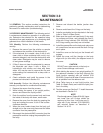
14
MODEL 381pH/ORP SECTION 2.0
INSTALLATION
2.9.2 Calibration
CAUTION
The solution used during the following check
is an acid and should be handled with care.
Follow the directions of the acid manufactur-
er. Wear the proper protective equipment. Do
not let the solution come in contact with skin
or clothing. If contact with skin is made,
immediately rinse with clean water.
1. Make a temporary electrical connection between the
sensor and the instrument.
2. Obtain a standard solution of saturated quinhydrone
(PN R508-160Z). This can also be made quite sim-
ply by adding a few crystals of quinhydrone to either
pH 4 or pH 7 buffer. Quinhydrone is only slightly sol-
uble therefore a few crystals will be required. (Refer
to Section 4.3. for an alternate ORP standard solu-
tion).
3. Immerse the sensor in the standard solution. Allow
1-2 minutes for the ORP sensor to stabilize.
4. Adjust the standardize control of the instrument to
the solution value shown in Table 2-1. The resulting
potentials, measured with a clean platinum electrode
and saturated KCl/AgCl reference electrode, should
be within ±20 millivolts of the value shown in Table 2-
1. Solution temperature must be noted to insure
accurate interpretation of results. The ORP value of
saturated quinhydrone solution is not stable over
long periods of time. Therefore, these standards
should be made up fresh each time they are used.
TABLE 2-1.
ORP of Saturated Quinhydrone Solution
(In Millivolts)
5. Remove the sensor from the buffer, rinse and install
in the process.
2.7 START-UP AND CALIBRATION
2.8 MODEL 381 pH and pHE
2.8.1 SENSOR PREPARATION. Shake down the
sensor to remove any air bubbles that may be present
at the tip of the pH glass bulb. In most cases, the pH
sensor can simply be installed as shipped and read-
ings with an accuracy of ± 0.6 pH may be obtained. To
obtain greater accuracy or to verify proper operation,
the sensor must be calibrated as a loop with its com-
patible analyzer or transmitter.
WARNING
Glass electrode must be wetted at all times
(in storage and in line) to maximize sensor
life.
2.8.2 CALIBRATION USING BUFFER SOLUTIONS
OR GRAB SAMPLES. The pH sensor-analyzer/ trans-
mitter loop may be calibrated by submersing the sensor
in a buffer solution (standard solutions of known pH val-
ues) or in a process grab sample whose pH value
maybe checked by a calibrated laboratory or portable
pH meter. Please refer to the analyzer's or the trans-
mitter’s respective instruction manuals for proper
calibration procedures.
2.9 MODEL 381 ORP.
2.9.1 MODEL 396P ORP. Most industrial applications
have a number of ORP reactions occurring in
sequence or simultaneously. There can be several
components that are oxidized or reduced by the
reagents that are used. Theoretically, the ORP poten-
tial is absolute because it is the result of the oxidation-
reduction equilibrium. However, the actual measured
potential is dependent on many factors, including the
condition of the surface of the ORP platinum elec-
trode. Therefore, the sensor should be allowed 1-2
hours to become “conditioned” to the stream
when first set-up or after being cleaned.
pH 4 Solution pH 7 Solution
Temp °C 20 25 30 20 25 30
Millivolt Potential 268 264 260 94 87 80


















